Hitting your peak
A Slice of the Rockies in Texas? Exploring Guadalupe Mountains National Park
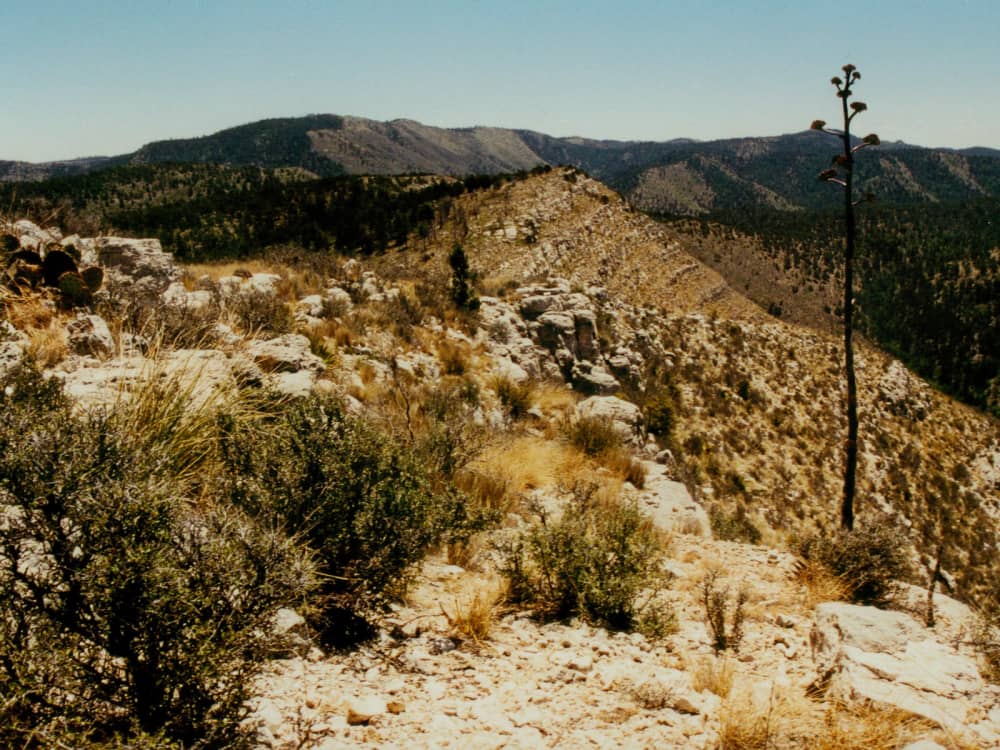 The Guadalupe Mountains represent the southernmost extent of the RockyMountains, harboring rugged canyons, lowland desert, and high elevation forest.Photo by Stephan Lorenz
The Guadalupe Mountains represent the southernmost extent of the RockyMountains, harboring rugged canyons, lowland desert, and high elevation forest.Photo by Stephan Lorenz Devil’s Hall, a unique slot canyon, will get hikers off the beaten path.Photo by Stephan Lorenz
Devil’s Hall, a unique slot canyon, will get hikers off the beaten path.Photo by Stephan Lorenz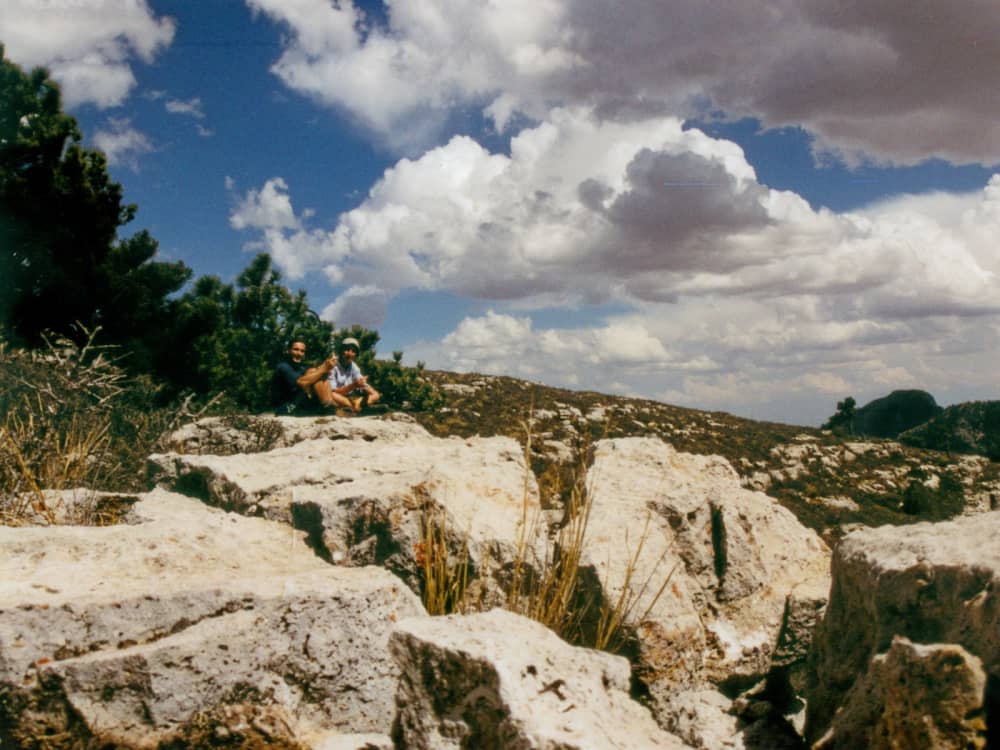 Several peaks in the Guadalupe Mountains reach over 8,000 feet, including BushMountain. My brother and I are taking a break near the summit during a four-daybackpacking trip.Photo by Stephan Lorenz
Several peaks in the Guadalupe Mountains reach over 8,000 feet, including BushMountain. My brother and I are taking a break near the summit during a four-daybackpacking trip.Photo by Stephan Lorenz The backcountry in the Guadalupe Mountains offers endless solitude andphotographic opportunities.Photo by Stephan Lorenz
The backcountry in the Guadalupe Mountains offers endless solitude andphotographic opportunities.Photo by Stephan Lorenz Dog Canyon, near the New Mexico state line, is a little visited area of the parkwith broad views and pinyon-juniper woodland.Photo by Stephan Lorenz
Dog Canyon, near the New Mexico state line, is a little visited area of the parkwith broad views and pinyon-juniper woodland.Photo by Stephan Lorenz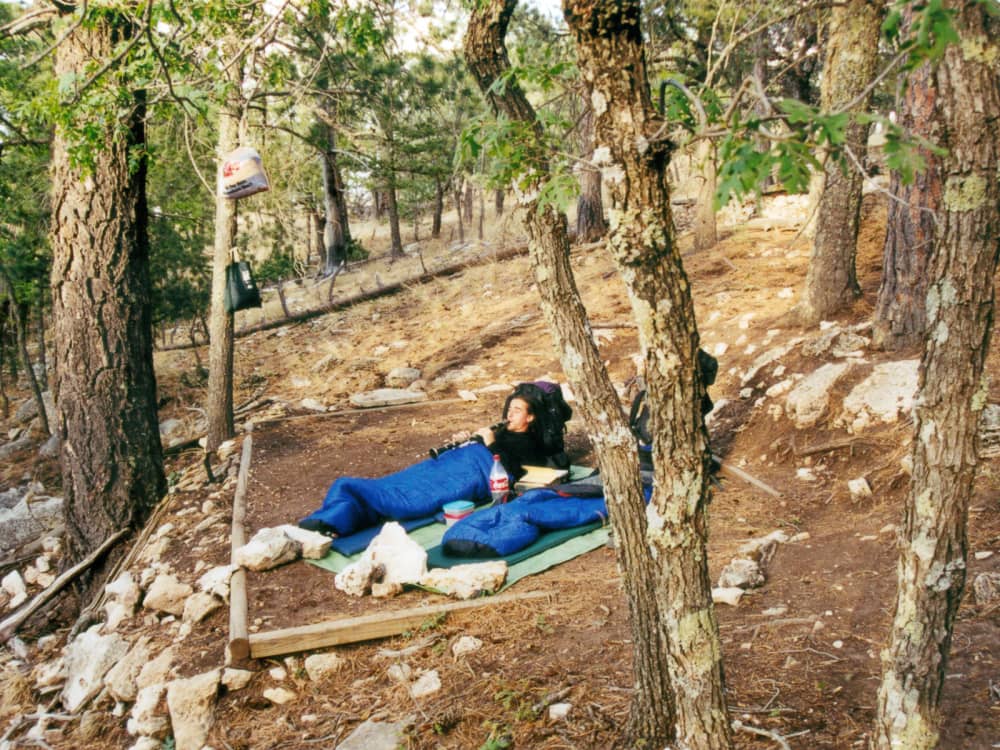 There are several primitive campsites located along the major trails throughoutthe wilderness area. (Just in case there is any confusion - yes, my brother isplaying a clarinet we packed in addition to the ramen.)Photo by Stephan Lorenz
There are several primitive campsites located along the major trails throughoutthe wilderness area. (Just in case there is any confusion - yes, my brother isplaying a clarinet we packed in addition to the ramen.)Photo by Stephan Lorenz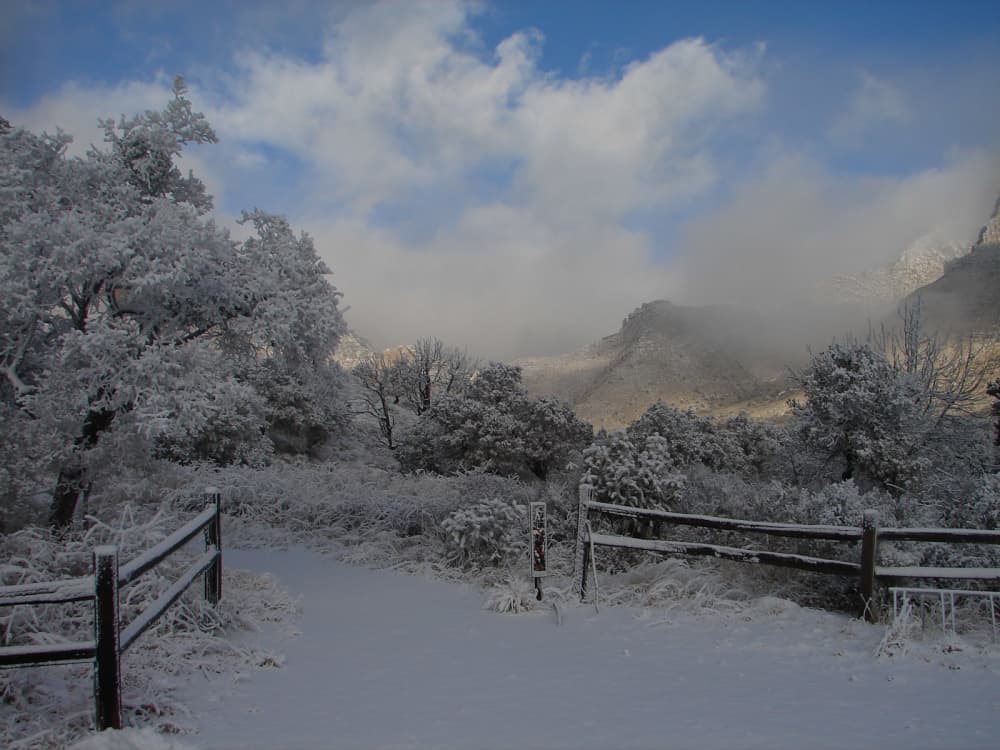 Weather conditions can be rough. Here, a January storm covered trees inhoarfrost and the mountains in snow.Photo by Stephan Lorenz
Weather conditions can be rough. Here, a January storm covered trees inhoarfrost and the mountains in snow.Photo by Stephan Lorenz More than 80 miles of maintained trails wind through the national park, offeringaccess to the mountains. Here, the switchbacks of a trail are visible in theforeground and salt flats in the background.Photo by Stephan Lorenz
More than 80 miles of maintained trails wind through the national park, offeringaccess to the mountains. Here, the switchbacks of a trail are visible in theforeground and salt flats in the background.Photo by Stephan Lorenz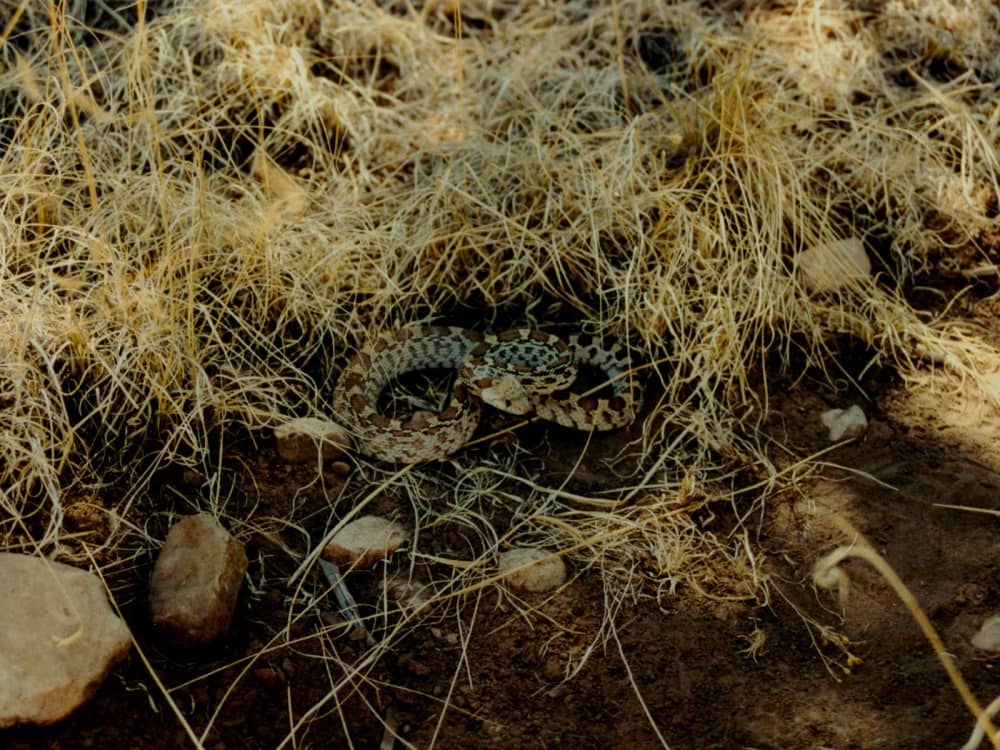 Animals abound, like this snake. It may look like a rattler, but is actually aharmless bull snake. The backcountry is also home to mountain lions, blackbears, and a plethora of birds.Photo by Stephan Lorenz
Animals abound, like this snake. It may look like a rattler, but is actually aharmless bull snake. The backcountry is also home to mountain lions, blackbears, and a plethora of birds.Photo by Stephan Lorenz
It was day three of an unplanned four-day experiment. How long would five pounds of cooked, unrefrigerated ramen noodles remain palatable in the west Texas summer weather?
The result? A three-pound slimy mass that did not smell very good, much less appear edible. I dumped the goo in the vicinity of Lost Peak, the ninth highest summit in Texas.
Although littering is frowned upon in a national park, I reasoned it was not really littering — since the bears were going to get it. I guess feeding wildlife is also frowned upon, but ramen is kind of natural, right?
I quickly turned away, my stomach growling, but we had several more miles to go, and the packs were not getting any lighter.
Why carry cooked noodles stuffed into a plastic bag for rations on a backpacking trip? Are we idiots? Nah. I would say we were hardcore.
Fueling for 40 (miles)
My brother and I had arrived in Guadalupe Mountains National Park two days before, in hopes of traversing the range and back on a 40-mile backpacking trip.
Checking on conditions, we found that, due to extreme drought and heat, any open fires had been banned in the backcountry. Which meant no roasting marshmallows, no stoves, and no cigarettes. I was even too worried to turn on my flashlight.
Not easily discouraged, we huddled around our food supply. Since the park’s remote location is not conducive to a quick run to the store, we spent two hours cooking 14 packages of ramen, methodically draining the water and dumping the finished product into a bag, all in the safety of the developed campground.
After zippering away the little flavor packets, we deemed ourselves prepared for the trip. Additional fare included oatmeal, powdered milk, and granola bars.
These measly rations turned out to provide enough energy to power us up, over, and down the mountains. Twice.
Far, far from home
The Guadalupe Mountains National Park sits in a remote corner of the state, abutting the New Mexico border, with the closest major city being El Paso. Its little visited 86,000 acres protect pristine desert, scorching salt flats, rugged peaks and lush canyons.
Just getting there is half a road trip. From Houston, it is a straight shot west for about 10 soporific hours. But you must take care not to fall asleep passing through San Antonio — the highways are just weird there.
The tiny, dusty town of Van Horn marks the turn north onto Highway 54, and the last chance for restaurants and an actual bed. I find Van Horn’s aesthetic value and interest factor to be zero.
After another hour of driving, the dramatic prow of El Capitan — a cliff face rising to more than 8,000 feet — becomes visible.
For fans of geology, these mountains were formed as a reef beneath an ancient inland sea, before uplifting formed jagged summits flanked by vertical cliffs. The exposed peaks and escarpments are now recognized as some of the most well-preserved fossil reefs in the world.
Gaming the Guadalupe
The best way to truly appreciate the mountains is to camp and hike for a couple of days. The park has a little more than a mile of paved road, but more than 80 miles of maintained trails.
My brother and I backpacked for four days into the heart of the wilderness area. The most direct route into the high country follows Pine Spring Canyon on the Tejas Trail. With heavy packs, we slogged uphill for three miles before reaching the cool woodlands of the Bowl.
Above 6,000 feet, the desert and grassland give way to forest of ponderosa pine, gambel oak, and Douglas-fir - survivors from an epoch when the area experienced a cooler climate. Here, flora and fauna more typical of the Rocky Mountains further north can be found.
After crossing Bush Mountain, the second highest peak in Texas, we camped for the night amidst old growth of pine and oak.
Not a soul as far as the eye can see
The next day, we descended to Dog Canyon into juniper woodland. Close to the New Mexico border, Dog Canyon has a ranger station and developed campground where we were able to refill our dwindling water supply, since no water is available in the higher parts of the park.
Over the last two days of the trip, we followed another trail back across the mountains. We finished the trek coming down the arduous Bear Canyon, which shaved a couple of years off my knees.
We didn’t see a single person on the trails during the entire four days.
Sometimes, ramen doesn't cut it
In addition to backpacking, there are plenty of day hikes in the park. Peak-skill baggers can tackle the nine and a half miles round-trip up Guadalupe Peak, which, at 8,749 feet, is the highest point in Texas.
One sun bleached spring day, I scrambled to its rocky summit, after four hours of stoic back and forth along endless switchbacks. I settled, exhausted, on the first flat-ish rock I gazed at, the desert and salt flats nearly 5,000 feet below.
Two hikers popped onto the summit and exclaimed in slightly higher than conversational tone of how surprised they were that it only took one hour to reach the top.
Maybe I did need better nutrition.
Are we still in Texas, Toto?
A short drive north from the main visitor center at Pine Springs, McKittrick Canyon offers a welcome reprieve from the desert. Here, a year-round stream, flowing clear and cool across smooth slabs of gray rock, supports rich woodlands of oak and aspen.
The trail following the canyon eventually becomes nearly vertical. However, the first few miles are pretty flat, and lead past a historic lodge and fern-lined grottoes.
A day hike to Devil’s Hall, a near-perfect rectangular box canyon no more then 20 feet wide, will get you off the beaten track. The path starts at the main trail head at Pine Spring Canyon, but soon turns into a bit of a scramble down a dry creek bed, eventually ending near a formation called the Devil's Staircase.
Hitting this spot, you may be scratching your head profusely, asking yourself, "Is this really Texas?"
Many areas in the Guadalupe Mountains National Park make it hard to believe that you're still in Texas. But then again, it's pretty neat to not have to cheat on your state to have a small dose of those Rocky Mountains.

 The newly opened Totally Tejano Hall of Fame and Museum includes a growing collection of memorabilia. Photo by Edmond Ortiz
The newly opened Totally Tejano Hall of Fame and Museum includes a growing collection of memorabilia. Photo by Edmond Ortiz